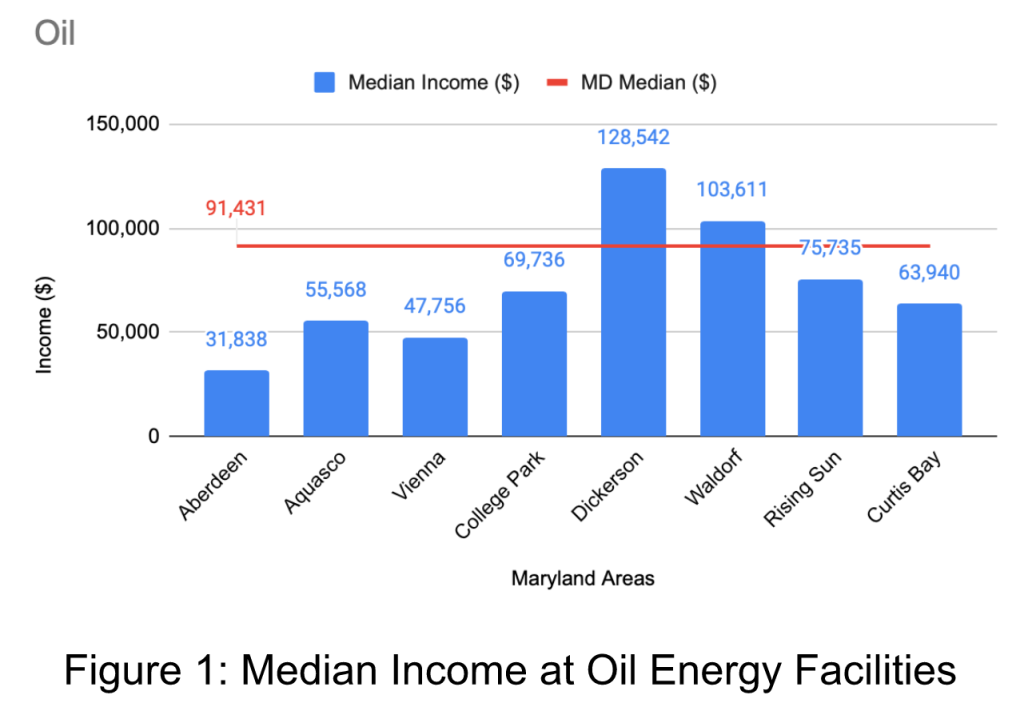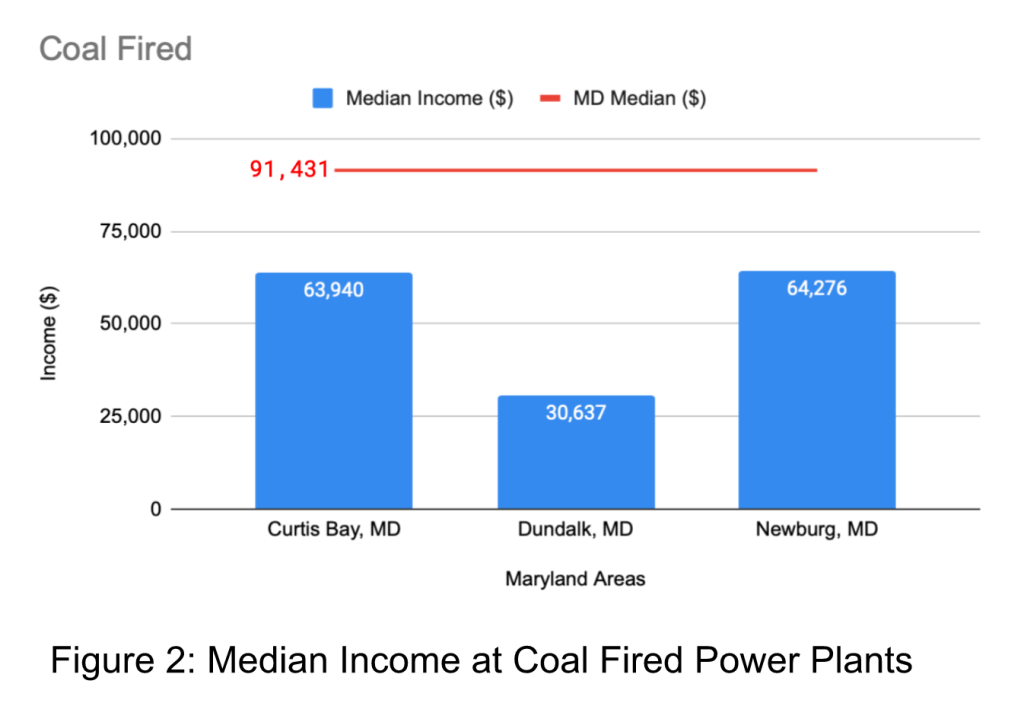Coal Smoking Power Plant/ Deposit Photos from https://www.popsci.com/story/environment/coal-plant-closure-save-lives-crops/
Discrimination and Air Pollution
By Livi Sonne, Senior at Walt Whitman High School
It is not much of a surprise that chemicals such as carbon dioxide, sulfur dioxide, and nitrogen oxides are harmful to the human body. These byproducts are in abundance around harmful power plants scattered around the world, the US, and Maryland in particular. Who wants to live in these terrible conditions? The simple answer is, no one. In fact, the presence of these pollutants in the air and water cause property values in the surrounding area to decrease, creating low-income communities and a repeating cycle of poverty for their families. (National Institute of Environmental Health Sciences).
Coal, nuclear, and oil-based power plants pollute the environment by causing water and air contamination, harming not just the wildlife living in it, but also the conditions of the drinking water of citizens nearby the plants. In fact, there are 5.5 billion pounds of pollution released into rivers, streams, lakes, and bays each year in the US. (Natural Resources Defense Council). This causes drinking water to be contaminated with carcinogens, one of the leading causes of lung and kidney cancers. As well as lower income areas having to face the burden of contaminated drinking water, the air around these harmful power plants is also polluted, causing Fine Particulate Matter (PM) levels to rise. Exposure to high PM levels for long periods of time can lead to bronchitis, reduced lung function, and lower life expectancy (Reuters). The effects of natural gas production from power plants is a leading cause of pollution in both the air and water and these effects are most faced by lower income areas.


Due to this pollution, people generally do not want to live near natural gas power plants. However, the problem is affordability. People who live near these harmful power plants have no choice because it is what these families can afford. As seen in Figure (2), in Dundalk, Maryland, the location of a coal power plant, the median household income is $30,637 each year. Relative to the average Maryland household income of $91,431, the income near this coal plant is clearly less than what it could be in the absence of the plant. This trend of lower income around coal power plants is also seen around oil power plants (Figure 1). The median household income in Aberdeen, the location of an oil power plant, is a mere $31,838. Through these statistics, it can be seen that the production of natural gas has a direct correlation with lower-income areas. The lower income of these areas, clearly a byproduct of lower quality living conditions, is caused by the negative effects of these types of dangerous plants on the environment.
The environmental harm done by these plants is seen clearly through the fact that more than 90 percent of Maryland’s greenhouse gas emissions take the form of carbon dioxide emissions from fossil fuel combustion (Maryland Geological Survey). It should be made a goal to reduce CO2 emissions, as supported by a study published in 2022 by the Plos One journal. The study found that a decrease in CO2 emissions by 1.99 metric tons per capita was correlated with an increase in median life expectancy by 2.36 years (Rahman). Interestingly enough, the harvesting of energy through neither hydroelectric nor solar power plants emit CO2, suggesting that unlike nuclear, coal, and natural gas power plants, solar and hydroelectric power plants have far fewer negative effects on the environment. Clearly, solar power has no negative effects on water, and hydroelectric power only uses water without really affecting it. Through this, we can see a clear benefit of using either of these two options instead.
When the median income by harmful power plants is compared to the median income by the greener alternatives, it is not surprising that areas with cleaner power plants, such as hydroelectric, solar and wind power, have a higher median income. For instance, the median income of Rockville, MD, the location of a solar power plant, is $116,031, which is much greater than the MD median income. Similarly, the Damascus, MD area surrounding a wind farm has a median income of $137,399, nearly $50,000 above the state median. To the contrary, the median income for the majority of harmful power plants are below the state median. This perpetuates the cycle of poverty and the regeneration of low income areas near harmful power plants.
The concentration of power plants in lower-income areas is a clear manifestation of environmental injustice. The negative effects of power plant emissions, such as air pollution and respiratory illness, are disproportionately borne by those who are least able to cope with them. This inequity not only impacts human health, but also perpetuates systemic poverty, limits economic opportunities, and undermines the quality of life in affected communities. It is imperative that we address this issue by demanding greater accountability from power plant operators, donating to environmental justice organizations, advocating for stronger environmental regulations, and investing in clean energy solutions that promote both environmental and social justice. By taking action, we can ensure that all communities have access to clean air, safe water, and a healthy environment.
References
Cleaning up coal ash and power plant pollution [White paper]. (2022, November 4). Clean Water Action. Retrieved January 15, 2023, from https://cleanwater.org/campaign/cleaning-coal-ash-and-power-plant-pollution
Coal power impacts [White paper]. (2017, November 17). Union of Concerned Scientists. Retrieved January 15, 2023, from https://www.ucsusa.org/resources/coal-power-impacts#:~:text=Air%20pollution%20from%20coal%2Dfired ,environmental%20and%20public%20health%20impacts
Conn, C. (n.d.). Potential for geologic storage of CO2 in western Maryland [White paper]. Maryland Geological Survey. Retrieved January 15, 2023, from http://www.mgs.md.gov/documents/co2seqpaper.pdf
Environmental impacts of natural gas [White paper]. (2014, June 19). Union of Concerned Scientists. Retrieved January 15, 2023, from https://www.ucsusa.org/resources/environmental-impacts-natural-gas
Failey, T. (n.d.). Poor communities exposed to elevated air pollution levels. National Institute of Environmental Health Sciences. Retrieved January 15, 2023, from https://www.niehs.nih.gov/research/programs/geh/geh_newsletter/2016/4/spotlight/poor_communities_exposed_to_elevated_air_pollution_levels.cfm
Failey, T. (n.d.). Poor communities exposed to elevated air pollution levels. National Institute of Environmental Health Sciences. Retrieved January 15, 2023, from https://www.niehs.nih.gov/research/programs/geh/geh_newsletter/2016/4/spotlight/poor_communities_exposed_to_elevated_air_pollution_levels.cfm
Hyat, B. (2015, October 1). New power plant rules will reduce toxic pollution and save water. Natural Resources Defense Council. Retrieved January 15, 2023, from https://www.nrdc.org/experts/becky-hayat/new-power-plant-rules-will-reduce-toxic-pollution-and-save-water
Nuclear power plant accidents [Fact sheet]. (2019, December 16). Centers for Disease Control and Prevention (CDC). Retrieved January 15, 2023, from https://www.cdc.gov/nceh/multimedia/infographics/nuclear_power_plant_accidents.html#:~:text=Radioacti ve%20materials%20can%20also%20get,health%20effects%20such%20as%20cancer
Rahman, M. (2022, January 21). Determinants of life expectancy in most polluted countries: Exploring the effect of environmental degradation [White paper]. Plos One. Retrieved January 15, 2023, from https://journals.plos.org/plosone/article?id=10.1371/journal.pone.0262802
About the Author:
Livi Sonne, Senior at Walt Whitman High School
Livi is a 2022-2023 Environmental Leader. She is very excited to be a part of Bethesda Green’s Environmental Leaders Program. She is passionate about protecting the environment and wants to do her part in making local change. She hopes to apply what she learns working with Bethesda Green to a future career in environmental protection. Outside of the environment, her passions include running, hiking, swimming, and painting.





